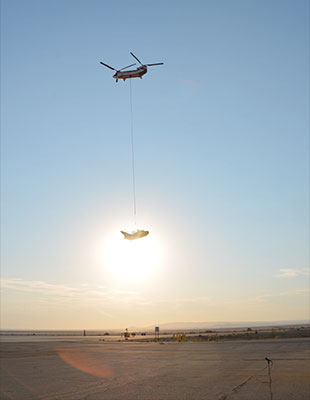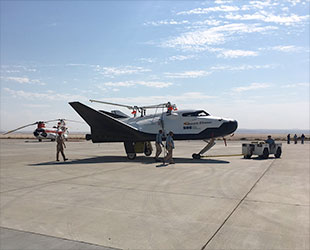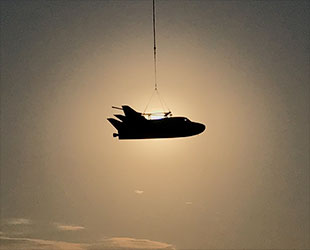August 31, 2017 – A small space plane was lifted into the skies over southern California on Wednesday (Aug. 30), in a test supporting future commercial cargo deliveries to the International Space Station.
A Columbia 234-UT Chinook helicopter flew Sierra Nevada Corporation's Dream Chaser engineering test article on a "captive carry" flight above the dry lake bed at Edwards Air Force Base and NASA Armstrong Flight Research Center. The one hour and 41 minute-long fight was the first of two captive tests before a "free flight," or drop test, planned for later this year.
"Liftoff!" announced Steve Lindsey, vice president of Sierra Nevada Corporation (SNC) space exploration systems and a former NASA astronaut, during a live webcast of the test. "Not something you see every day."
Originally proposed for a NASA contract to fly astronauts to and from the space station, SNC's Dream Chaser is one of three private craft selected by the space agency in 2016 to continue resupply services for the orbiting outpost. SNC is targeting the maiden launch of the Dream Chaser atop a United Launch Alliance (ULA) Atlas V rocket in 2020.
"This [captive carry] test is another indication the Dream Chaser is on track for meeting our key milestones on the way to orbital spaceflight," said Lindsey in a post-test-flight statement. "We are excited to move through the remaining ground and flight testing."
Dream Chaser déjà vu
Wednesday's flight test, which collected data to refine the space plane systems for the upcoming free flight, was the second first captive carry for the Dream Chaser.

A Columbia 234-UT Chinook helicopter lifts the Dream Chaser over Edwards Air Force Base for a captive carry test on Aug. 30. (SNC) |
On May 29, 2012, an Erickson Air-Crane helicopter lifted the prototype spacecraft for its first captive carry flight near the Rocky Mountain Metropolitan Airport in Colorado. The successful test was conducted under NASA's commercial crew development program while the SNC Dream Chaser was still competing with the Boeing CST-100 Starliner and SpaceX Dragon for the contract to ferry crew members to the space station.
A second captive carry flight test was conducted on Aug. 22, 2013, again by an Air-Crane helicopter, but this time at the Armstrong Flight Research Center (then Dryden Flight Research Center) in California. The Dream Chaser flew for 3 miles (5 kilometers) over the dry lake bed at Edwards Air Force Base to an altitude of 12,400 feet (3,800 meters).
The two captive carries led up to first free flight on Oct. 26, 2013. The vehicle performed better than expected in flight, but a problem deploying the left landing gear ended in the uncrewed spacecraft skidding off the runway and suffering damaged.
Two years later, SNC announced that it was preparing the atmospheric engineering test article for a second phase of flight tests. In January of this year, the vehicle was shipped from the company's assembly facility in Colorado to NASA Armstrong.
Prior to both phases, the space plane underwent tow tests behind a truck, accelerating the Dream Chaser to as much as 60 mph (97 kp/h) to verify its autonomous steering and braking systems for the free flight.

Sierra Nevada Corp.'s Dream Chaser space plane to towed back to its hangar at NASA Armstrong Flight Research Center. (SNC) |
Though the engineering test article is still outfitted with the windows, static wing configuration and exterior coloring as the earlier crewed version, it supports the flight systems for the cargo variant of the orbital vehicle.
"The avionics onboard today are identical to what we have on the orbital vehicle, as well as the flight software," said Lindsey. "Getting this flight complete [and] when we do the free flight, will actually test our flight software and avionics, and that it is why it is so critical for us."
Historic enterprise
"We are the only commercial lifting body in the world right now," said Lindsey, commenting on the rarity of the captive carry test on Wednesday.
For its resupply flights, the Dream Chaser will be outfitted with a cargo module, equipped with solar arrays to power its on-orbit operations. It will shed the module before it re-enters the Earth's atmosphere and flies to a touchdown on the Shuttle Landing Facility at the Kennedy Space Center in Florida.

The captive carry test collected data to support a free flight for the Dream Chaser, scheduled for later this year. (NASA) |
Based on the design of the HL-20, an early-1980s NASA concept for a lifting body re-entry craft, the Dream Chaser has wings but derives 70 percent of its lift from the shape of its body.
"Interestingly, the space shuttle was not a lifting body. The space shuttle was actually a winged vehicle," said Lindsey. "However, the flying characteristics of the space shuttle, its lift over drag and aerodynamic characteristics, were almost identical to [Dream Chaser]. So in terms of performance, it is very much the same."
The Dream Chaser currently shares another similarity with the retired space shuttle – through its location. The hangar housing the small space plane at NASA Armstrong is the same that was used to support the shuttle during the 30-year program.
"In the early days, the shuttle program, before they started flying to space, they had a vehicle called Enterprise. And Enterprise was their atmospheric test vehicle, which is the same thing as we have out here," stated Lindsey. "We are basically doing the same profile that Enterprise did, so it is really an honor that NASA put us into this hangar, in the same location."
